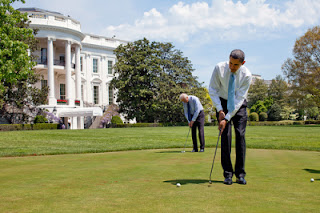You can't manage what you don't measure. It is an old management adage that is accurate today. Unless you measure something you don't know if it is getting better or worse. You can't manage for improvement if you don't measure to see what is getting better and what isn't. This article may help you know what to measure and how.
Definitions
To begin, we'll define a few of the terms. We are using "measure" as a verb, not a noun and "benchmark" as a noun, not adverb.
• Measure: The verb means "to ascertain the measurements of"
• Measurement: The figure, extent, or amount obtained by measuring"
• Metric: "A standard of measurement"
• Benchmark: "A standard by which others may be measured"
So, we collect data (measurements), determine how those will be expressed as a standard (metric), and compare the measurement to the benchmark to evaluate progress. For example, we can measure the time it takes to set-up the golf course each morning, by the number of employees multiplied by the time each crew member takes to complete their task. Then we need to measure the number of tasks the crew accomplishes before players begin to fill the course. We also need to measure (count) the number of break-downs, bad cups, misaligned tee markers, ropes and traffic control items moved, bunkers raked, etc. in that set-up process. That's how we will establish "our quality rating" for golf course set-up, expressed as the metric. We compare each crew members metric against the benchmark of "time and quailty rating for golf course set-up".

To manage and measure those activities is important to successfully achieving your organization's goals. Key Performance Indicators, also known as KPI or Key Success Indicators (KSI), help an organization define and measure progress toward its goals.
They differ depending on the organization. A golf course may have as one of its Key Performance Indicators as the time it takes to prepare the golf course for daily play. Another golf course may have as one of its KPIs the percentage of golfers returning to play the course. As routine maintenance changes a return golfer count may correlate to maintenance operations (the number one reason a golfer is satisfied with a golf experience is course conditioning). Still another Key Performance Indicator for a golf course maintenance organization might be the gross revenue compared with routine maintenance costs.
You may need to measure several things to be able to calculate the metrics in your KPIs. To measure progress toward the organizations goals you may consider the time it takes to maintain the course, rounds played, average time to play 18-holes and time to schedule large scale mowing (rough and fairways). Many golf course operations take advantage of off peak time (late in the day) to mow fairways and rough in an effort to increase efficiencies and cause less disruption of play.
How To Measure
How you measure is as important as what you measure. In the previous example, we can measure square footage, time and quality. We could have an assistant or foreman checking time spent and quality of raked bunkers and ballmark repair while changing hole-cups. Another option would have a golf shop assistant take a tour of the course check conditions and work on player relations simultaneously. The biggest challenge is that measurements are current, accurate, complete, and unbiased.
Collecting the measurements enables the superintendent to calculate the percentage of time and quality increases or decreases in relationship to other maintenace eliments and weather. In addition, it provides additional measurements that help the superintendent manage toward improving the percentages through additional training, more efficient equipment, increases or decreases in staff or time allotments and scheduling time of day to accomplish tasks.
How To Use Measurements
Most often, these measurements are used as part of a Continuous Improvement Plan like the
Shewhart cycle.
Similar plans are used by many companies in different industries and given different names, but the goal is the same - to measure the key factors and improve them.
It is important that you communicate your metrics both up and down the organization. Your GM, committee, board or owner(s) wants to know what's going on, but your employees need to know also. They are not motivated to improve unless they know how they are doing. In addition, most of the suggestions on how to improve will come from them.
Post team and individual results, either on line or just by hanging charts on the wall. Use pie charts, line charts, key driver charts, and other graphs to quickly, easily, and visually communicate the metrics.
Review your metrics and use them to guide your decisions. With your metrics in place, you can tell which strategies are working and which aren't. If you make a change, you use the metrics to tell you whether the change improved things or not.
When the metrics show improvement, share that success with everyone. Tell your staff. Tell your boss. Tell the guy you meet on the course. And don't forget to reward the people who were responsible for the success, even if it's just a verbal pat on the back.
Measure To Manage
• Measure what's important.
• Publish your metrics and benchmarks.
• Reward people for exceeding their goals.
• And then start over.
You'll be a better superintendent if you do.

